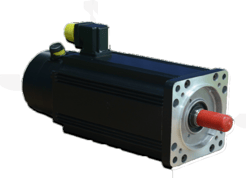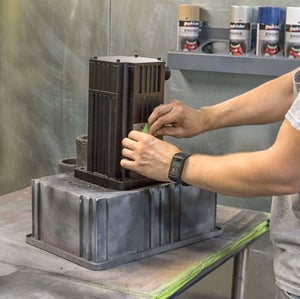When an industrial motor fails, there are two options: repair or replacement. The best option for a motor depends on a variety of factors, and cost isn’t the only factor considered.
Reduce Downtime With an Industrial Motor Failure Policy
A motor failure policy is a plan or set of procedures implemented when an electric motor or other types of motors fail. These policies aim to ensure operational efficiency, minimize downtime, and reduce costs associated with repairs or replacements.
Establishing a motor failure policy and repair guidelines can reduce downtime, lower energy expenses, and maximize capital investments. It’s important to have a game plan before a motor fails to enable informed, data-driven motor-management decisions that consider safety, risk, and costs.
A strong motor failure policy should consider the following:
1. Horsepower Breakpoint (Above to Repair, Below to Replace)
Depending on your electric rate, repair cost, distributor discount on new motors, the efficiency of your failed motor, and its annual run hours, it may be more cost-effective to replace your motor than repair it. Some asset management system add-ons enable you to calculate near-real-time motor repair-versus-replace business cases. However, facilities without this technology may find it helpful to calculate their horsepower breakpoint.
To calculate the horsepower breakpoint, evaluate the costs for repairing and replacing common motor sizes, including full lifecycle operating costs. If a new motor will last longer than a rebuilt motor, consider only the costs that the new motor will incur over the expected lifetime of the repaired motor.
To calculate the horsepower breakpoint, evaluate the costs for repairing and replacing common motor sizes, including full lifecycle operating costs. If a new motor will last longer than a rebuilt motor, consider only the costs that the new motor will incur over the expected lifetime of the repaired motor.
.jpg?width=300&name=49F746AE-FD9F-4891-9996-FD8E94F65051PRINTBW%20(2).jpg) Next, calculate the horsepower and operating hours above which it becomes more cost-effective to repair a motor based on your company’s payback or internal rate of return criteria. These calculations inform the facility’s particular rule of thumb. For example, replace all motors falling below this horsepower breakpoint; repair everything at and above it.
Next, calculate the horsepower and operating hours above which it becomes more cost-effective to repair a motor based on your company’s payback or internal rate of return criteria. These calculations inform the facility’s particular rule of thumb. For example, replace all motors falling below this horsepower breakpoint; repair everything at and above it. Why consider lifecycle costs? Energy expenses comprise up to 97% of a motor’s total lifecycle cost. Even a one-point rise in efficiency translates into tremendous savings over the motor’s service life. Considering full lifecycle costs may also impact the decision to repair versus replace.
2. Identify Improperly-Specified Industrial Motors
Given the high capital cost of new motors, motor failures offer an opportunity to evaluate the appropriateness of a motor in its application.
Identify motors and locations with frequent failures, then perform (or ask your preferred repair shop to perform) a root cause failure analysis (RCFA). Once the reasons behind chronic motor failures have been identified, a business case can be built, and corrective action can begin. For example, if a harsh environment causes frequent motor failures, replace the motors with severe-duty motors, increasing motor reliability and reducing downtime. Similarly, a motor with damaged windings may indicate an electrical issue at the plant.
Replacing oversized, under-loaded motors—those running at less than 50% of their capacity—with smaller, premium efficient motors that better match the load requirements reduces the cost of capital expenditure and increases the motor’s operating efficiency, reducing energy spend.
Identify motors and locations with frequent failures, then perform (or ask your preferred repair shop to perform) a root cause failure analysis (RCFA). Once the reasons behind chronic motor failures have been identified, a business case can be built, and corrective action can begin. For example, if a harsh environment causes frequent motor failures, replace the motors with severe-duty motors, increasing motor reliability and reducing downtime. Similarly, a motor with damaged windings may indicate an electrical issue at the plant.
Replacing oversized, under-loaded motors—those running at less than 50% of their capacity—with smaller, premium efficient motors that better match the load requirements reduces the cost of capital expenditure and increases the motor’s operating efficiency, reducing energy spend.
3. Communicate Your Motor Repair or Motor Replace Plan
For critical motors, downtime will far exceed the cost to repair or replace the motor. But that doesn’t mean there isn’t time to apply these principles.


A motor failure plan should be communicated and transparent to all equipment operators and maintenance technicians to ensure continuity. Place easily identifiable tags on each motor to communicate the correct course of action upon that motor’s failure. Use the tag to identify whether to repair or replace the motor.
If replacing, indicate where to find its spare, whether on-site or stocked off-site with a contracted vendor. For motors not stocked on-site, check the availability of spares quarterly. Many motor manufacturers produce motors in batches, meaning the available stock for specific size and speed motors will vary. Critical and essential spare shortages can lead to higher prices or an operational shutdown.
Increasingly, firms use outside vendors to manage their spare parts inventory. In addition to reducing (or even eliminating) inventory carrying costs, spares management firms can share the risks associated with obsolescence, shrinkage, overstocking, and depreciation. These supply-chain management vendors also often bring industry-specific expertise on failure rates of similar equipment and benefit from economies of scale on the price of spares they stock.
At the very least, a retainer agreement should be established with a preferred motor supplier and repair shop to ensure local availability of spares and guaranteed repair turnaround times.
Industrial Motor Repair Guidelines
There is no way to justify replacing all failed motors. Repairing the motor will be the best option for at least a few motors, particularly if upgraded to premium-efficiency motors.
Studies by W.U. McGovern, R.S. Colby & D.L. Flora and others show that motor efficiency drops an average of 1% on the first repair, with further decline with repeated rewinds. Yet, studies conducted by the Electrical Apparatus and Service Association (EASA) and Advanced Energy have proven that motor rewinding can, in fact, improve motor efficiency by up to 1% when the shop embraces certain recognized best practices.
Motor repair guidelines help protect the performance of repaired motors, ensuring they achieve the same speed, torque, and efficiency as they did when new. At a minimum, motor repair guidelines should address who performs motor repairs and the quality of the job - such as whether repairs are performed in-house or outsourced and what repair procedures are followed. Two questions that should be answered are:
1. Who repairs the industrial motors?
If motor repairs are outsourced, motor repair guidelines should identify the preferred vendor and criteria for assessing whether a repair shop is equipped to perform best-practice-level motor repairs. At a minimum, a service center should be able to provide a root-cause analysis on motor failure, spell out each repair/replacement option, highlight their prior experience servicing similar motors, and outline their repair procedures and warranty details.

2. Best Practices For Repairing Industrial Motors
Whether repairs occur in-house or are outsourced, requiring ANSI/EASA AR100 best practices helps maintain and even enhance the energy efficiency and reliability of repaired motors. The AR100 standard provides a comprehensive list of best practices covering mechanical repair, electrical repair, rewinding, and testing.
Best practices prescribed by AR100 include
- Providing a quality assurance program and warranty
- Replacing all broken and worn parts per OEM specifications
- Conducting stator core tests both before and after winding removal to check for stator core damage
- Repairing or replacing defective stator core laminations
- Calibrating all test equipment and measuring devices at least once yearly to the national standard to ensure accuracy
- Recording winding resistance and room temperature before and after repair to ensure that the resistance measured is within spec and balanced on all three phases
- Carrying out insulation resistance tests, surge comparison tests, high-potential tests, nominal, and no-load testing
- Regulating power supply to ensure good power quality at the appropriate rated voltage for motor tests
The relationship with the service center is key to receiving the quality promised by the AR100 standard. Rushing the repair can result in sub-optimal motor efficiency and reliability. Find out about Radwell International’s motor repair capabilities.
Nicole Dyess is director of client solutions at Motors@Works, a CFE Media Content Partner.
View the original article and related content on Plant Engineering








